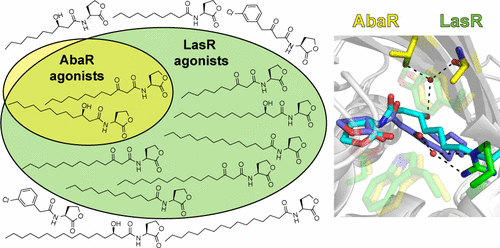当前位置:
X-MOL 学术
›
ACS Chem. Biol.
›
论文详情
Our official English website, www.x-mol.net, welcomes your feedback! (Note: you will need to create a separate account there.)
Chemical Interrogation of LuxR-type Quorum Sensing Receptors Reveals New Insights into Receptor Selectivity and the Potential for Interspecies Bacterial Signaling
ACS Chemical Biology ( IF 4 ) Pub Date : 2017-08-31 00:00:00 , DOI: 10.1021/acschembio.7b00458 Joseph P. Gerdt 1 , Danielle M. Wittenwyler 1 , Joshua B. Combs 1 , Michelle E. Boursier 1 , Jacob W. Brummond 1 , He Xu 1 , Helen E. Blackwell 1
ACS Chemical Biology ( IF 4 ) Pub Date : 2017-08-31 00:00:00 , DOI: 10.1021/acschembio.7b00458 Joseph P. Gerdt 1 , Danielle M. Wittenwyler 1 , Joshua B. Combs 1 , Michelle E. Boursier 1 , Jacob W. Brummond 1 , He Xu 1 , Helen E. Blackwell 1
Affiliation

|
Cell–cell signaling between bacteria, including quorum-sensing (QS) communication systems, may play a role in the establishment and maintenance of polymicrobial communities. To better understand and model these interactions, we must uncover the degree to which neighboring species recognize each another’s signals. In the current study, we tested the likelihood of whether the QS systems of two opportunistic pathogens (Acinetobacter baumannii and Pseudomonas aeruginosa) that frequently arise in polymicrobial infections would be affected by the QS signals of neighboring species. Through the synthesis and screening of a library of native and non-native N-acyl l-homoserine lactones (AHLs), we found that the AbaR LuxR-type receptor protein of A. baumannii is highly selective for its native AHL signal. However, a homologous LuxR-type receptor in P. aeruginosa, LasR, is far more promiscuously activated by AHLs relative to AbaR, suggesting that LasR-regulated QS could be more susceptible to activation by neighboring species. To explain the observed difference in signal selectivity between AbaR and LasR, we developed a model based on (i) the activity profiles of these proteins and (ii) previously reported structural data and activity profiles for related LuxR-type receptors. This model may facilitate the study of signal selectivities for hundreds of LuxR-type QS receptors from bacteria, many of which grow in polymicrobial communities and may sense each other’s signals. In addition, we discovered a set of AHLs that could be used to selectively activate LasR and selectively inhibit AbaR in polymicrobial experiments.
中文翻译:

LuxR型群体感应受体的化学询问揭示了新的见解,对受体的选择性和种间细菌信号传递的潜力。
细菌之间的细胞间信号传递,包括群体感应(QS)通信系统,可能在建立和维持微生物群落中发挥作用。为了更好地理解和建模这些相互作用,我们必须揭示相邻物种识别彼此信号的程度。在本研究中,我们测试了在微生物感染中频繁出现的两种机会性病原体(鲍曼不动杆菌和铜绿假单胞菌)的QS系统是否会受到邻近物种的QS信号影响的可能性。通过合成和筛选天然和非天然N-酰基l的文库-高丝氨酸内酯(AHLs),我们发现鲍曼不动杆菌的AbaR LuxR型受体蛋白对其天然AHL信号具有高度选择性。然而,铜绿假单胞菌中的同源LuxR型受体相对于AbaR,LasR(即LasR)更容易被AHL激活,这表明LasR调节的QS可能更容易被邻近物种激活。为了解释观察到的AbaR和LasR之间信号选择性的差异,我们基于(i)这些蛋白质的活性谱和(ii)先前报道的有关LuxR型受体的结构数据和活性谱建立了模型。该模型可能有助于研究来自细菌的数百种LuxR型QS受体的信号选择性,其中许多受体在微生物群落中生长并且可以感知彼此的信号。此外,我们发现了一组AHL,可用于在多微生物实验中选择性激活LasR和选择性抑制AbaR。
更新日期:2017-08-31
中文翻译:

LuxR型群体感应受体的化学询问揭示了新的见解,对受体的选择性和种间细菌信号传递的潜力。
细菌之间的细胞间信号传递,包括群体感应(QS)通信系统,可能在建立和维持微生物群落中发挥作用。为了更好地理解和建模这些相互作用,我们必须揭示相邻物种识别彼此信号的程度。在本研究中,我们测试了在微生物感染中频繁出现的两种机会性病原体(鲍曼不动杆菌和铜绿假单胞菌)的QS系统是否会受到邻近物种的QS信号影响的可能性。通过合成和筛选天然和非天然N-酰基l的文库-高丝氨酸内酯(AHLs),我们发现鲍曼不动杆菌的AbaR LuxR型受体蛋白对其天然AHL信号具有高度选择性。然而,铜绿假单胞菌中的同源LuxR型受体相对于AbaR,LasR(即LasR)更容易被AHL激活,这表明LasR调节的QS可能更容易被邻近物种激活。为了解释观察到的AbaR和LasR之间信号选择性的差异,我们基于(i)这些蛋白质的活性谱和(ii)先前报道的有关LuxR型受体的结构数据和活性谱建立了模型。该模型可能有助于研究来自细菌的数百种LuxR型QS受体的信号选择性,其中许多受体在微生物群落中生长并且可以感知彼此的信号。此外,我们发现了一组AHL,可用于在多微生物实验中选择性激活LasR和选择性抑制AbaR。



























 京公网安备 11010802027423号
京公网安备 11010802027423号